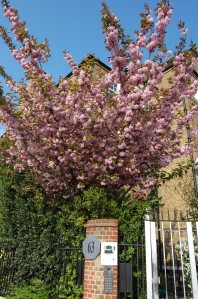Position: Full sun
Soil: Moist,well drained
Flowering period: Late spring
Eventual Height: 10m
Eventual Spread: 10m
Hardiness: 5a, 5b, 6a, 6b, 7a, 7b, 8a, 8b, 9a
Family: Rosaceae
Prunus serrulata ‘Kanzan’ is a deciduous tree with an upright, vase-shaped habit. Its leaves are ovate, long, dark green leaves, which are bronze when young. Its leaves turn yellow, red or crimson in autumn before they fall. It bears deep pink, double flowers profusely in clusters of 2-5. As the cultivar is sterile it will not bear fruit.
The species Prunus serrulata, commonly know as the Japanese Cherry, is native to Japan, Korea and China. The plant features heavily in the traditions of Japan, with its blossoms symbolising the ephemerality of life among other things and the blossoms are even used to make tea called Sakurayu, prepared by pickling the petals in plum vinegar and salt, then drying them and adding boiling water.
The etymological root of the binomial name Prunus is from the classical Latin name of the Plum tree. Serrulata is derived from the Latin meaning ‘small toothed’ referring to the leaf margins in this plant. The name ‘Kanzan’ is a Japanese word from classical poetry, meaning literally ‘bordering the mountain’, it may also reference a Zen hermit sage & eccentric called Kanzan, he was a poet-monk who dwelt in a cave and wrote about Cherries that shone in the morning light as with crimson fire.
With its dramatic spring flowering and upright habit Prunus serrulata ‘Kanzan’ is useful to the landscape architect. This plant looks fantastic when planted in avenues or lines, spaced at regular centres. However, care should be taken as all members of the Prunus genus are shallow rooting, and their roots may become exposed, deforming paved surfaces or areas of grass as it matures.
Prunus serrulata ‘Kanzan’ prefers alkaline soil but will tolerate a wide pH range so long as the soil is free draining and will rarely require additional lime.
Ecologically, Prunus serrulata ‘Kanzan’ will attract pollinating insects such as bees that will feed on its nectar.
The Royal Horticultural Society have given Prunus serrulata ‘Kanzan’ their prestigious Award of Garden Merit.
Prunus serrulata ‘Kanzan’ requires little pruning once established. Pruning should be carried out after flowering, from April to July to minimise the risk of Silver leaf infection. If planted in a lawn, the grass should be strimmed under the tree rather than mown as the mower may damage the roots causing the plant to send up new shoots.







One Response to “Prunus serrulata ‘Kanzan’”